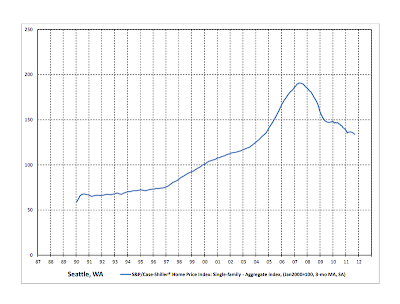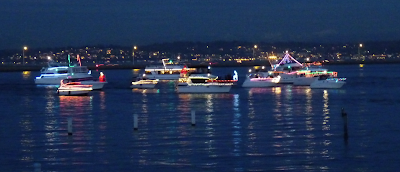What goes down must come up?
As we’ve learned to our dismay in recent years, real estate values cannot permanently defy that old adage, “What goes up must come down.” Having endured more than four years of declining values since the bubble burst in the summer of 2007, Seattle-area homeowners may be forgiven for now wondering “Are we there yet?” For surely at some point we’ll reach bottom, this demoralizing downward trend will reverse course, and appreciating homes values will again be the natural order of things.
 |
| The Case-Shiller Home Price Index for Seattle shows the peak for single family home values in the Seattle area and the almost imperceptible double dip that followed. (Click to enlarge) |
It’s probably too soon to say that the fundamentals, either on the national or local levels, have changed dramatically enough for an immediate reversal of the negative home-value trend. But there is some solid evidence that the Seattle market could come back faster and stronger than most of the rest of the country. The primary reasons for hope are the trends for employment growth and rising personal income in the region.
Last month the federal government reported that Washington led the nation in personal-income growth in the third quarter. This was driven principally by gains in the software, aerospace and manufacturing sectors, among others, which are occurring in our part of the State. The U.S. Labor Department places King County’s current median household income in the top 20% nationally. Meanwhile, unemployment in Washington fell from 9.3% in August to 8.7% in December. Seattle’s unemployment rate is closer to 8%. Positive news about future employment increases at Boeing and in the software industry adds to the overall picture of an employment recovery in the Puget Sound region.
Unsurprisingly, there is a direct correlation between personal income and home prices. In general, when people have more money to spend, more demand is created for housing, and house values are bid up as the supply goes down. So the good news about local employment and income trends should ultimately have a direct impact on the housing market here. In fact, a recent forecast by Fiserv predicts Seattle will experience a 13.7% increase in house values for the year starting with the second quarter of 2012. Most forecasters agree, however, that the local market has a bit further to fall before the uptick begins.
One of the reasons for this is that even with a 30% decline since the peak, the median-home value here is still above historic highs as measured relative to personal income. According to a recent analysis by Zillow, the Seattle market mirrors the national market in that home prices are still 14% above the historic norm, which before the real estate bubble was 3.0 (home prices being three times the level of personal income). Today that number is 3.30 both locally and nationally, says Zillow. On the positive side, however, our market is in significantly better shape than many (Boulder, Colorado is still 43% higher than the historic average, for example).
Seattle also remains a market where, according to a recent report by the Wall Street Journal, the “own versus rent” decision comes down in favor of renting (along with San Francisco, San Diego, and Washington, D.C.).
However, with interest rates at an historic low (under 4% for a conforming 30-year fixed mortgage this month) and foreclosures down in the Seattle area, conditions for a real estate renaissance are definitely strengthened for this market. Seattle is also one of the few major cities where the percentage of homeowners who are underwater on their mortgages is low (about 16% here versus over 60% for Las Vegas, for example). This makes conditions less ripe locally for escalating foreclosure levels than is true for much of the nation.
The bottom line is that the market may soon be ripe for upward movement, assuming that the employment and personal income pictures remain positive. The inventory of homes for sale is very low, so increases in demand could lead to price appreciation. Though 2012 may well prove to be a transition year for the local market, it‘s much too soon to be singing Hallelujah.























